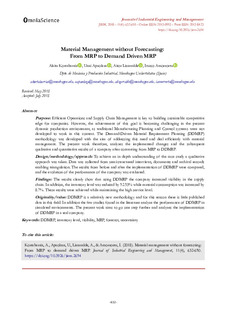| dc.rights.license | Attribution-NonCommercial 4.0 International | * |
| dc.contributor.author | Kortabarria, Alaitz | |
| dc.contributor.author | Apaolaza, Unai | |
| dc.contributor.author | Lizarralde, Aitor | |
| dc.contributor.author | Amorrortu, Itxaso | |
| dc.date.accessioned | 2019-11-19T10:26:08Z | |
| dc.date.available | 2019-11-19T10:26:08Z | |
| dc.date.issued | 2018 | |
| dc.identifier.issn | 2013-8423 Print | en |
| dc.identifier.issn | 2013-0953 Online | en |
| dc.identifier.other | https://katalogoa.mondragon.edu/janium-bin/janium_login_opac.pl?find&ficha_no=153542 | en |
| dc.identifier.uri | https://hdl.handle.net/20.500.11984/1502 | |
| dc.description.abstract | Purpose: Efficient Operations and Supply Chain Management is key to building sustainable competitive edge for companies. However, the achievement of this goal is becoming challenging in the present dynamic production environment, as traditional Manufacturing Planning and Control systems were not developed to work in this context. The Demand-Driven Material Requirement Planning (DDMRP) methodology was developed with the aim of addressing this need and deal efficiently with material management. The present work therefore, analyzes the implemented changes and the subsequent qualitative and quantitative results of a company after converting from MRP to DDMRP.
Design/methodology/approach: To achieve an in depth understanding of the case study a qualitative approach was taken. Data was collected from semi-structured interviews, documents and archival records enabling triangulation. The results from before and after the implementation of DDMRP were compared, and the evolution of the performance of the company was evaluated.
Findings: The results clearly show that using DDMRP the company increased visibility in the supply chain. In addition, the inventory level was reduced by 52.53% while material consumption was increased by 8.7%. These results were achieved while maintaining the high service level.
Originality/value: DDMRP is a relatively new methodology and for this reason there is little published data in this field. In addition the few studies found in the literature analyze the performance of DDMRP in simulated environments. The present work aims to go one step further and analyzes the implementation of DDMRP in a real company. | en |
| dc.language.iso | eng | en |
| dc.publisher | OmniaScience | en |
| dc.rights.uri | http://creativecommons.org/licenses/by-nc/4.0/ | * |
| dc.subject | DDMRP | en |
| dc.subject | inventory level | en |
| dc.subject | visibility | en |
| dc.subject | MRP | en |
| dc.subject | forecast | en |
| dc.subject | uncertainty | en |
| dc.title | Material management without forecasting: From MRP to demand driven MRP | en |
| dc.type | http://purl.org/coar/resource_type/c_6501 | |
| dcterms.accessRights | http://purl.org/coar/access_right/c_abf2 | en |
| dcterms.source | Journal of Industrial Engineering and Management | en |
| local.contributor.group | Dirección de operaciones logístico productivas | es |
| local.description.peerreviewed | true | en |
| local.description.publicationfirstpage | 632 | en |
| local.description.publicationlastpage | 650 | en |
| local.identifier.doi | http://dx.doi.org/10.3926/jiem.2654 | en |
| local.rights.publicationfee | APC | en |
| local.rights.publicationfeeamount | 295 € | en |
| local.source.details | Vol.11. Nº 4. Pp. 632-650. OmniaScience, 2018 | eu_ES |
| oaire.format.mimetype | application/pdf | |
| oaire.file | $DSPACE\assetstore | |
| oaire.resourceType | http://purl.org/coar/resource_type/c_6501 | en |
| oaire.version | http://purl.org/coar/version/c_970fb48d4fbd8a85 | en |








